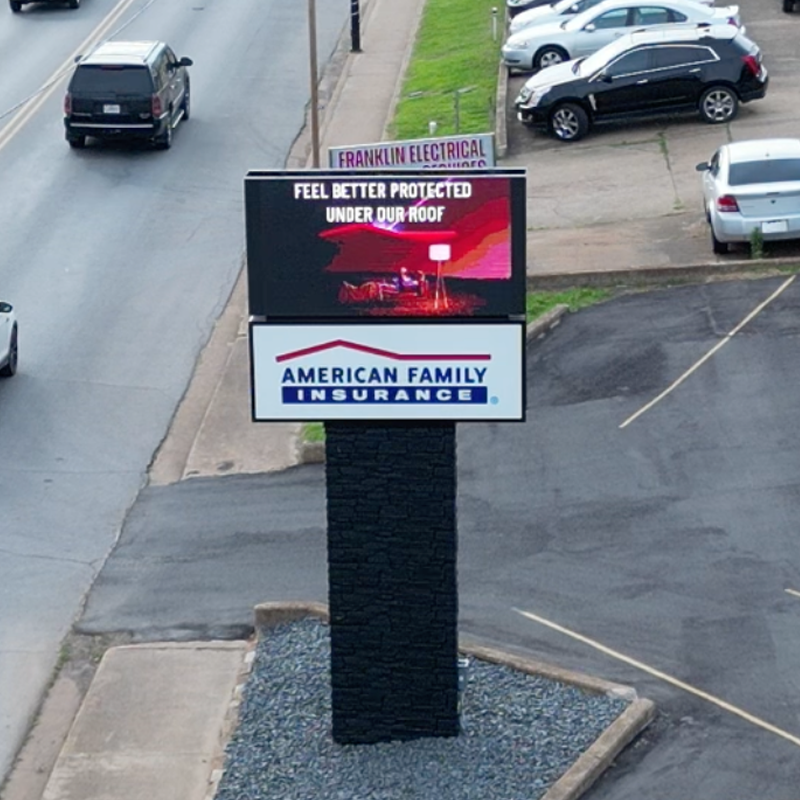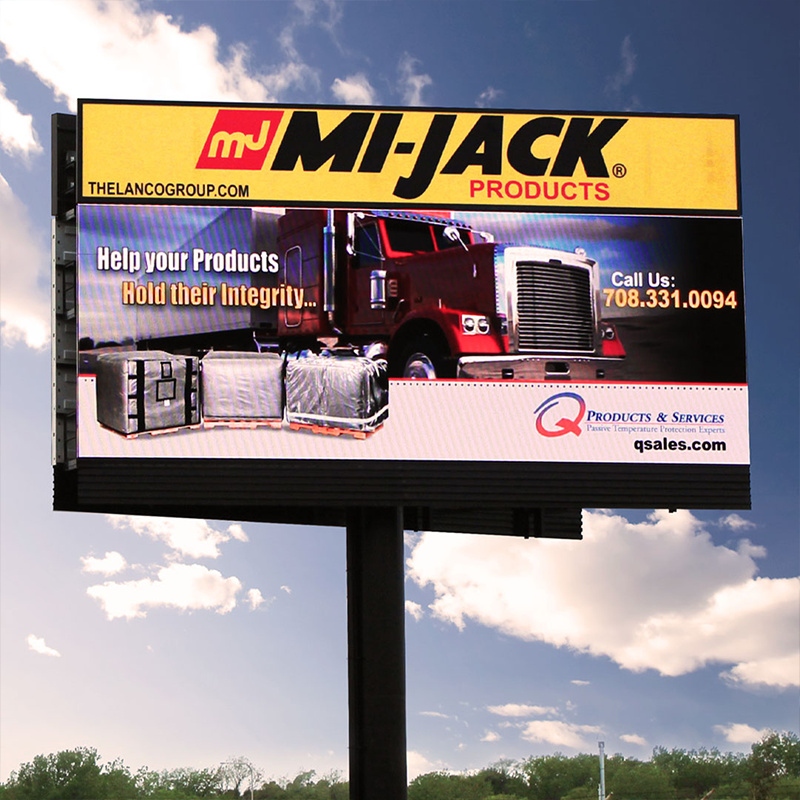Businesses and organizations rely on signage to attract attention, share information, and strengthen brand visibility. While traditional signs like printed banners, neon displays, and LCD screens each have their place, LED signage has become the preferred choice for companies focused on performance, energy efficiency, and long-term value. This guide compares LED displays to other popular signage types so you can make the best decision for your business.
LED Signage
Pros
High Visibility and Brightness
LED signs deliver exceptional brightness and clarity, making messages easy to read day or night, even in harsh sunlight or bad weather. Their vivid colors draw attention from passing traffic and increase brand exposure.
Energy Efficiency
Compared to neon or fluorescent lighting, LED signs use up to 70 percent less energy, lowering long-term operating costs and supporting sustainability goals.
Durability and Longevity
Quality LED signs can last 10 years or more (50,000 + hours of use) with minimal fading or dimming. Solid-state components resist shock, vibration, and temperature extremes, making them ideal for outdoor use.
Dynamic Content and Flexibility
With LED technology, messages can be updated instantly using scheduling software—no printing, shipping, or physical changeouts required. This saves time, reduces costs, and allows real-time marketing for events and promotions.
Cons
Higher Initial Investment
The upfront cost of LED signage is greater than static or printed signs, but the savings on energy, maintenance, and replacement quickly offset the difference.
Technical Setup
Managing dynamic content requires basic software knowledge or help from a content provider, though training and support are typically included.
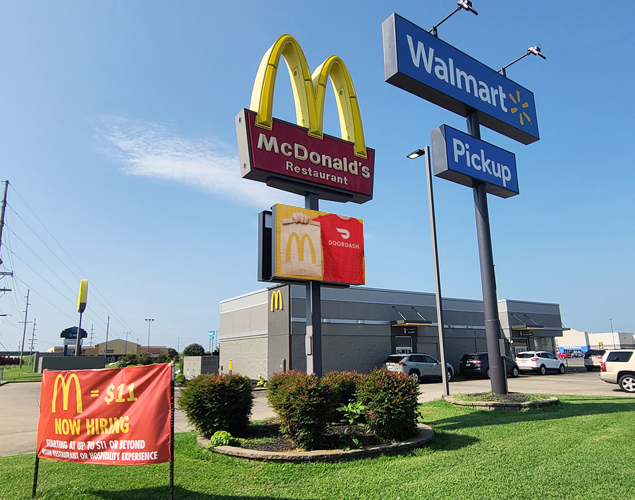
Neon Signage
Pros
Aesthetic Appeal: Neon provides a nostalgic, artistic look ideal for restaurants, bars, and boutique storefronts.
Brightness: Excellent nighttime visibility for mood lighting or brand accents.
Customization: Can be shaped into nearly any design or logo.
Cons
Energy Use: Neon signs draw significantly more power than LED displays.
Heat Output: They generate heat, which increases cooling costs in warm climates.
Fragility: Glass tubes are prone to breakage, leading to frequent repairs and higher maintenance costs.
Limited Lifespan: Typical neon lights last 15,000 – 30,000 hours — roughly half the life of an LED display.
LCD/Plasma Signage
Pros
- High-Definition Visuals: Produces crisp images and vibrant colors for indoor applications.
Interactive Options: Ideal for touch-screen kiosks or digital directories.
Versatility: Can display a wide range of static or motion content.
Cons
Power Consumption: Continuous operation can result in high electricity usage.
Screen Burn-In: Static images left for long periods can cause permanent damage.
Environmental Limitations: Not suited for bright sunlight or outdoor use due to glare and limited brightness levels.
Higher Maintenance: Screens are more susceptible to cracking or pixel failure.
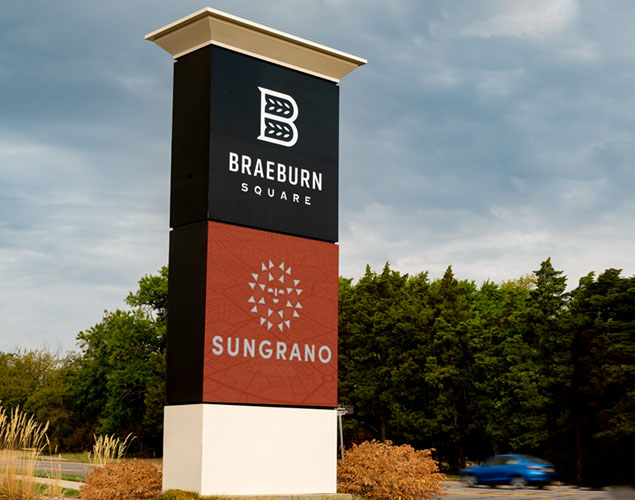
Printed Signage (Banners, Posters, Billboards)
Pros
Low Upfront Cost: Printed signs remain the most affordable option for short-term promotions.
Simple Production: No electrical setup or specialized training required.
Portability: Easy to move, replace, or reuse at different locations.
Cons
Static Content: Once printed, messaging cannot be updated without reprinting.
Visibility: Requires external lighting to be seen at night.
Short Lifespan: Weather exposure causes fading, tearing, or peeling, leading to frequent replacement.
Environmental Waste: Reprinting adds recurring material and disposal costs.
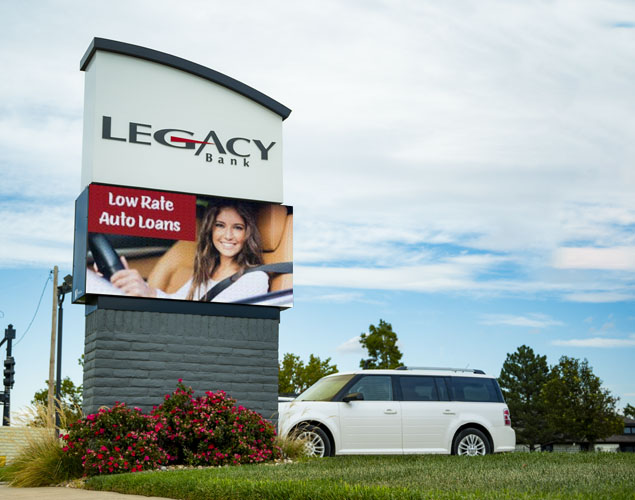
While each signage type serves its purpose, LED signage consistently delivers superior visibility, energy savings, and durability. Businesses switching from traditional options often cut their energy costs by up to 70 percent and eliminate recurring print or repair expenses. The ability to update content instantly provides unmatched flexibility for promotions and seasonal campaigns.
LED signage benefits include:
Bright, high-impact visuals in any lighting condition.
Lower lifetime ownership cost through energy efficiency and longevity.
Easy remote updates using scheduling software.
Reduced maintenance compared to neon or printed alternatives.
For many companies, the higher upfront investment quickly turns into measurable ROI through lower operating costs, better audience engagement, and increased revenue opportunities.
Making the Right Choice
Ultimately, the choice of signage depends on your business’s specific needs, budget, and environment. LED signs, like the STAX series, excel in delivering dynamic, durable, and high-impact visuals. Meanwhile, other options, such as printed signs or LCD displays, may be better suited for specific use cases or budget constraints.
At Next, we specialize in helping businesses choose the perfect signage solution for their unique needs. Whether you’re exploring LED signs, interactive displays, or other options, our team is here to guide you. Contact us today to learn how the right signage can transform your brand visibility and communication efforts.
FAQs: LED Signs vs. Traditional Signage
How much more do LED signs cost upfront compared to traditional signs?
LED signs require a higher initial investment than static or neon signage, but that difference is quickly offset by lower energy bills, minimal maintenance, and a much longer lifespan. Most businesses find the total cost of ownership is lower within two to three years.
How much energy do LED signs save compared to traditional illuminated or neon signs?
LED displays use up to 70 percent less electricity than neon or fluorescent lighting. This efficiency not only cuts operating costs but also reduces environmental impact and heat output.
How often do messages need to be changed on a traditional sign versus an LED sign?
Traditional signs require manual replacement—printing, shipping, and installation—each time the message changes. LED signs can be updated instantly using software, allowing for real-time scheduling, promotions, and seasonal content with no physical work required.
What’s the difference in visibility between LED and traditional signs, day and night?
LED signs maintain consistent brightness and readability in any lighting condition, even direct sunlight. Traditional signs depend on ambient or external lighting and often lose visibility during daylight hours or inclement weather.
Do LED signs last longer than traditional neon or fluorescent signs?
Yes. A well-built LED display can last 10 to 12 years, while neon or fluorescent signs typically need replacement within 4 to 6 years. LEDs also fade more slowly and are less prone to damage from vibration or temperature changes.
What kind of maintenance is required for LED signs compared to traditional signs?
LED signs require minimal maintenance—mostly occasional cleaning or module replacement. Neon and fluorescent signs often need frequent repairs due to glass tube breakage or gas leaks, while printed signage must be reprinted and replaced frequently due to fading or tearing.
Which type of sign is more durable and weather-resistant?
LED signs are built with sealed, weatherproof enclosures that protect against rain, heat, and cold. Traditional signs, particularly those using glass or vinyl, degrade faster when exposed to outdoor conditions.
Can existing traditional signs be upgraded to use LED lighting?
In some cases, yes. Retrofitting is possible if the structure and electrical system are in good condition. However, most businesses achieve better results and warranties with a new LED system designed specifically for their application.
Are LED signs a better choice for small businesses than traditional static signs?
Absolutely. Although the upfront cost is higher, the long-term ROI is better thanks to lower maintenance, improved visibility, and the ability to promote specials or community messages anytime—without reprinting or installation fees.
Do LED signs have a negative environmental impact compared to traditional signs?
No. LEDs are environmentally friendly, using far less energy and containing no hazardous materials like mercury. Their long lifespan means fewer replacements and less waste compared to printed or neon alternatives.

